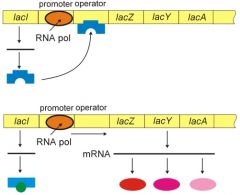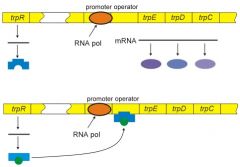![]()
![]()
![]()
Use LEFT and RIGHT arrow keys to navigate between flashcards;
Use UP and DOWN arrow keys to flip the card;
H to show hint;
A reads text to speech;
47 Cards in this Set
- Front
- Back
|
Transcription is what in general?
|
making an RNA copy of a piece of DNA
|
|
|
Transcription Step 1
|
RNA polymerase binds to promoter
|
|
|
Transcription Step 2
|
RNA polymerase separates the two strands of DNA
|
|
|
Transcription Step 3
|
RNA polymerase adds ribonucleotides complementary to that of DNA
|
|
|
Transcription Step 4
|
RNA polymerase does this until it reaches the terminator on the DNA
|
|
|
In what direction does transcription take place
|
5' to 3'
|
|
|
operon
|

a portion of the original DNA strand corresponding to one or more gene under control of a single promoter. the promoter, gene1, gene2, terminator complex is the operon here.
|
|
|
Translation step 1
|
30S subunit of ribosome binds to AUG start codon
|
|
|
Translation step 2
|
initiator tRNA binds to 30S subunit
|
|
|
Translation step 3
|
50S ribosomal subunit binds to form a 70S
|
|
|
Translation step 3
|
P site and A site
|
|
|
Translation step 4
|
peptide bond forms between two amino acids one on each P and A site
|
|
|
Translation step 5
|
P site is no longer attached to amino acid
|
|
|
Translation step 6
|
elongation takes place now as the ribosome moves down the rna unit
|
|
|
Translation step 7
|
nonsense codon encounter and release factor binds to A site
|
|
|
Describe the practical function of a tRNA molecule
|
rosetta stone: each tRNA is specific to a codon on the mRNA. if a matching tRNA doesn't exist for a codon (nonsense codon), then that indicates the end of a gene. once a specific tRNA binds a specific codon, a specific amino acid is created adjacent to the tRNA. specific codon = specific AA, but tRNA is the middle man.
|
|
|
Translation step 8
|
ribosome is released, completing translation
|
|
|
What are the start and stop points in an operon for a gene?
|
The points are more functionally represented on the mRNA that is the product of transcription, which are:
Promoter starts operon AUG start codon starts gene Nonsense codon stops gene Termintor stops operon |
|
|
When a signal turns transcription ON, what is that called?
|
Induction, this is an INDUCIBLE system. The molecular signal is called an inducer.
|
|
|
When a signal turns transcription OFF, what is that called?
|
Repression, this is a REPRESSIBLE system. The molecular signal is called a corepressor
|
|
|
Example of inducible system?
|
lac operon uses lactose as an inducer. so when lactose is present, the enzymes needing lactose as a carbon source are made. lactose is available, enzymes are made. lac makes enzymes.
|
|
|
Example of repressible system?
|
trp operon uses tryptophan as a corepressor, so when tryptophan is present, no tryptophan needs to be made. trp makes tryptophan. tryptophan is there, no more needs to be made.
|
|
|
What is positive control?
|
a type of system transcription control where the protein that regulates transcription turns transcription on (activator) by helping RNA polymerase bind to the promoter
|
|
|
What is negative control?
|
a type of system transcription control where the protein that regulates transcription turns transcription off (repressor) by preventing RNA polymerase from bind to the promoter
|
|

In the absence of lactose, the lacI gene makes a repressor protein that binds to a region of DNA
called the operator. When the repressor is bound to the operator, it prevents RNA polymerase from initiating transcription. When lactose is present, it is converted into the inducer, allolactose. The allolactose binds to the repressor protein and inactivates it. Now the RNA polymerase can initiate transcription and transcribe the three lac genes. What type of control system is the lac operon? |
The lac operon is inducible because
lactose turns it on. It is negatively controlled because the regulatory protein turns transcription off. |
|

In the absence of tryptophan, the trpR repressor is made, but is inactive. RNA polymerase can
initiate transcription and the five trp polypeptides are made. In the presence of tryptophan, the trp repressor is active. It binds to the operator and prevents RNA polymerase from transcribing the trp genes. What type of control system is the trp operon? |
The trp operon is repressible because
tryptophan turns it off. It is negatively controlled because the regulatory protein turns transcription off. |
|
|
What type of control is the ara operon under if the following is true:
In the absence of arabinose, the activator protein is made, but is inactive. RNA polymerase can’t initiate transcription at the promoter, and the three ara genes are not transcribed. In the presence of arabinose, the activator protein becomes active. It binds to the activator binding site and allows RNA polymerase to initiate transcription. The three enzymes made allow the cell to use arabinose as a carbon and energy source. |
The ara operon is inducible because
arabinose turns it on. It is positively controlled because the regulatory protein turns transcription on. |
|
|
What is catabolite repression?
|
it is an operons ability to selectively and heirarchically use sugars for metabolism based on preference. such ash when the lac operon uses a form of positive control by CAP regulatory protein. in the presence of glucose, CAP is not made, and so it does not assist the RNA polymerase to initiate transcription at the promoter. when glucose is absent CAP is made and acts as positive control to do just that.
|
|
|
How does control mechanisms relate to MRSA?
|
MRSA has a gene that if transcribed can produce an enzyme (beta-lactamase) that will break down certain antibiotics (beta-lactam antibiotics, penicillin family). The antibiotics themselves are the activators, so when you Dx an infection, culture the sample with a small amount of penicillin to inactive the repressor for the BlaZ gene so you can see the BlaZ product - beta-lactamase.
|
|
|
What is transformation?
|
a method of genetic exchange where a cell picks up free DNA from the environment
|
|
|
What is transduction?
|
a method of genetic exchange where a cell obtains DNA from a virus.
|
|
|
What is conjugation?
|
a method of genetic exchange where DNA is transferred directly between cells.
|
|
|
What do you call a cell that is capable of transformation?
|
competent
|
|
|
What are 4 examples of competent bacterial species?
|
Haemophilus influenzae, Streptococcus pneumoniae, Bacillis species and Neisseria species.
|
|
|
What are plasmids?
|
pieces of DNA, usually circular that exist in the cytoplasm of a cell, but are not integrated into the nucleoid. they are self duplicating
|
|
|
What role do phages play in transduction?
|
A phage will pick up DNA from one cell and inject it into another cell. The source of the DNA is the "donor," and the destination is the "recipient."
|
|
|
What is specialized transduction?
|
A type of transduction where a phage releases DNA into bacteria, the phage DNA is integrated into the chromosome, excises itself from the chromosome, then self duplicates as phage in the cytoplasm until lysis occurs.
|
|
|
What are names for phages that undergo specialized transduction?
|
Lysogenic, temperate, specialized transducing
|
|
|
What is the significance of the lambda phage?
|
It is a classic example of a lysogenic phage that additionally incorporates an extra 'gal' gene from the donor into it's DNA which is passes to the recipient, so that the recipient then has two 'gal' genes, which is referred to as 'Gal'
|
|
|
What is the significance of the F plasmid?
|
this is a plasmid that exists in bacteria cells and can be transferred by conjugation. The F plasmid containing cell is called an F+ cell and can make F pili in order to accomplish conjugation.
|
|
|
What is an F- bacterial cell?
|
A bacterial cell lacking the F plasmid and correspondingly cannot make F pili, nor do they need them if they don't have the plasmid.
|
|
|
What is the process of conjugation with the F plasmid?
|
F+ cell makes F pili that attaches to F- cell, F plamid self duplicates, and copy moves to F- cell, so that the product is F+ cells.
|
|
|
What is an F' (F-prime) cell?
|
A cell in which the F plasmid integrated into the chromosome, then extracted from the chromosome, but as a result, pulled a part of the chromosome out with it, so that now it has an F' plasmid.
|
|
|
What is one of the primary conjugation related reasons for antibiotic resistance?
|
R-plasmids that contain antibiotic resistant genes that exist in Gram(-) bacteria and can transfer between ANY Gram(-) bacteria.
|
|
|
What is an insertion sequence (IS)?
|
the simplest kind of transposable element in a DNA molecule. usually < 2000 bases with inverted repeats at each end which allows them to enter and exit DNA by means of a protein sequence
|
|
|
What is a transposon?
|
A pair of ISs with a gene in the middle. This is significant because now we can move antibiotic resistance that exists in a gene around in DNA.
|
|
|
What is a conjugative transposon?
|
Transposons that can move between bacterium. Bacterium do not have to be the same genus, they can also be either Gram (+) or Gram (-).
|

